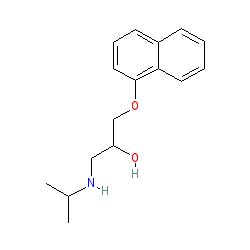GtoPdb is requesting financial support from commercial users. Please see our sustainability page for more information.
|
Synonyms: Bedranol® | Hemangiol® | Inderal® | propranolol hydrochloride
propranolol is an approved drug (FDA (1967), EMA (2014))
Compound class:
Synthetic organic
Comment: The approved drug propranolol is a racemic mixtue of (+)-propranolol and (-)-propranolol. We show the non-stereo molecule to represent the mixture.
Ligand Activity Visualisation ChartsThese are box plot that provide a unique visualisation, summarising all the activity data for a ligand taken from ChEMBL and GtoPdb across multiple targets and species. Click on a plot to see the median, interquartile range, low and high data points. A value of zero indicates that no data are available. A separate chart is created for each target, and where possible the algorithm tries to merge ChEMBL and GtoPdb targets by matching them on name and UniProt accession, for each available species. However, please note that inconsistency in naming of targets may lead to data for the same target being reported across multiple charts. ✖
View more information in the IUPHAR Pharmacology Education Project: propranolol |
|
|||||||||||||||||||||||||||||||||||
| No information available. |
Summary of Clinical Use  |
| Used in the prevention of migraine in adults. In 2014, the US FDA and EMA approved propranolol (Hemangiol®) as a treatment for infantile hemangioma ( "strawberry" birthmarks). |
External links  |
|
For extended ADME data see the following: Electronic Medicines Compendium (eMC) Drugs.com European Medicines Agency (EMA) |








